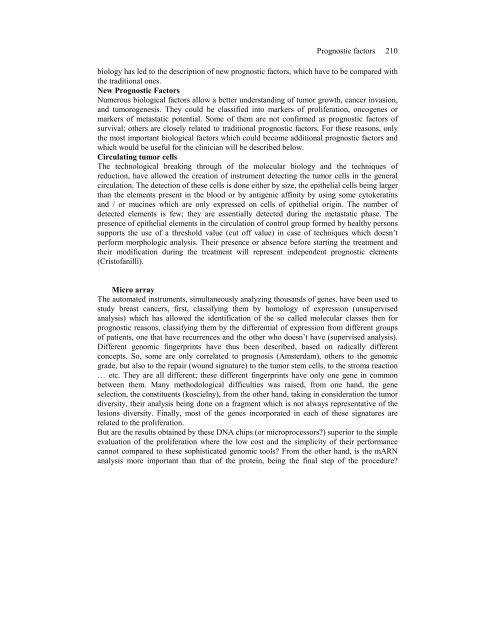Breast Cancer - Arab Medical Association Against Cancer
Breast Cancer - Arab Medical Association Against Cancer
Breast Cancer - Arab Medical Association Against Cancer
- No tags were found...
Create successful ePaper yourself
Turn your PDF publications into a flip-book with our unique Google optimized e-Paper software.
Prognostic factors 210biology has led to the description of new prognostic factors, which have to be compared withthe traditional ones.New Prognostic FactorsNumerous biological factors allow a better understanding of tumor growth, cancer invasion,and tumorogenesis. They could be classified into markers of proliferation, oncogenes ormarkers of metastatic potential. Some of them are not confirmed as prognostic factors ofsurvival; others are closely related to traditional prognostic factors. For these reasons, onlythe most important biological factors which could become additional prognostic factors andwhich would be useful for the clinician will be described below.Circulating tumor cellsThe technological breaking through of the molecular biology and the techniques ofreduction, have allowed the creation of instrument detecting the tumor cells in the generalcirculation. The detection of these cells is done either by size, the epithelial cells being largerthan the elements present in the blood or by antigenic affinity by using some cytokeratinsand / or mucines which are only expressed on cells of epithelial origin. The number ofdetected elements is few; they are essentially detected during the metastatic phase. Thepresence of epithelial elements in the circulation of control group formed by healthy personssupports the use of a threshold value (cut off value) in case of techniques which doesn’tperform morphologic analysis. Their presence or absence before starting the treatment andtheir modification during the treatment will represent independent prognostic elements(Cristofanilli).Micro arrayThe automated instruments, simultaneously analyzing thousands of genes, have been used tostudy breast cancers, first, classifying them by homology of expression (unsupervisedanalysis) which has allowed the identification of the so called molecular classes then forprognostic reasons, classifying them by the differential of expression from different groupsof patients, one that have recurrences and the other who doesn’t have (supervised analysis).Different genomic fingerprints have thus been described, based on radically differentconcepts. So, some are only correlated to prognosis (Amsterdam), others to the genomicgrade, but also to the repair (wound signature) to the tumor stem cells, to the stroma reaction… etc. They are all different; these different fingerprints have only one gene in commonbetween them. Many methodological difficulties was raised, from one hand, the geneselection, the constituents (koscielny), from the other hand, taking in consideration the tumordiversity, their analysis being done on a fragment which is not always representative of thelesions diversity. Finally, most of the genes incorporated in each of these signatures arerelated to the proliferation.But are the results obtained by these DNA chips (or microprocessors?) superior to the simpleevaluation of the proliferation where the low cost and the simplicity of their performancecannot compared to these sophisticated genomic tools? From the other hand, is the mARNanalysis more important than that of the protein, being the final step of the procedure?









